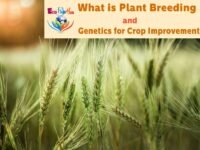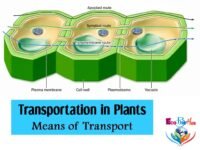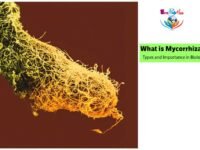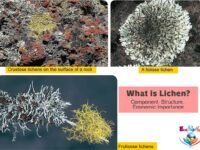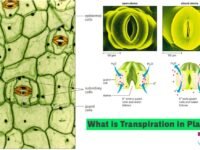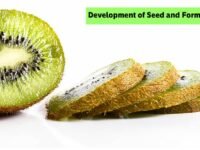In this tutorial, we have discussed ‘Type and Example of Biofertilizers, Organic & Chemical Fertilizers‘.
TABLE OF CONTENTS
WHAT ARE FERTILIZERS?
► DEFINITION:
Fertilizers are commercially produced synthetic chemicals added to the soil to maintain its fertility and have sustained plant growth. Since they are produced synthetically from inorganic material artificially, they do have some harmful acids which reduce the growth of soil microorganisms helpful for plant growth.
Fertilizers have played a major role in improving agriculture and increasing crop production. Being soluble in water, they are readily absorbed by plants and show an immediate effect on plant growth. Constant use of land leads to the loss of its important nutrients, particularly nitrogen and phosphorus leading to loss of soil fertility. Fertilizers in terms of nitrogen and phosphorus are applied to the land to regain its fertility.
► TYPES OF CHEMICAL FERTILIZERS
Fertilizers are generally grouped into the following three categories:
(01) Nitrogenous Fertilizers: Ammonium sulphate, ammonium nitrate, sodium nitrate and urea.
(02) Phosphate Fertilizers: Superphosphate, ammonium phosphate, bone meal, and rock phosphate.
(03) Potassium Fertilizers: Muriate of potash (KCI), sulphate of potash (K2SO4), and potassium nitrate.
The NPK fertilizers are also available as mixed fertilizers. Special care should be taken while applying them to the nursery to avoid injury to the seedlings. Adequate soil moisture is essential following the fertilizer application.
► NEED FOR THE APPLICATION OF FERTILIZERS
The deficiency of any one or more of the nutrients in the soil impairs the growth and development of the plant. Ultimately the yield of the crop plant is affected. The plants develop characteristic symptoms due to the deficiency of nutrients. These are called deficiency symptoms or ‘Hunger signs‘ of crops. Amongst the macroelements, Nitrogen (N), Phosphorus (P) and Potassium (K) are required in much larger amounts for plants. Referred to as NPK, these are also called the primary elements.
► ECONOMIC AND ECOLOGICAL ASPECTS OF THE USE OF CHEMICAL FERTILIZERS
(01) Chemical fertilizers are expensive.
(02) Their manufacture depends on the dwindling resources of energy such as petroleum and coal.
(03) Their production releases pollutants.
(04) Chemical fertilizers have high acid content like sulphuric acid (H2SO4) or hydrochloric acid (HCl). This causes the destruction of nitrogen-fixing bacteria which are helpful in supplying nitrogen to plants.
(05) Fertilizers applied to crop plants are lost in surface run-off water and pollute soil and nearby water resources.
► Read More: What is Mycorrhizae? Types and Importance in Biology ► Read More: Role of Microbes in Human Welfare ► Read More: Famous Scientists (Microbiologist, Molecular Biologist)
EXAMPLES OF BIOFERTILIZERS
(Fertilizers of Biological Origin)
The materials of biological origin which are commonly used to maintain and improve soil fertility are called biofertilizers. These are grouped into two main categories:
(01) Manures or Organic fertilizers
(02) Biofertilizers.
(01) MANURES / ORGANIC FERTILIZERS
Manures are organic substances of plant and animal origin. After partial decay, they are added to the soil to increase crop productivity. Manures supply all the essential elements required by the crop plants. They also improve the physical condition of the soil by protective action against erosion and leaching and add to the water holding capacity of the soil.
► Advantages of Manures
1. Manures enrich the soil with macro and micronutrients.
2. Manures provide organic matter to the soil that improves soil texture, better water retention and aeration in sandy soil and drainage of clayey soil.
3. These help in recycling of farm waste (leaves, etc).
4. Use of manures reduce environmental pollution.
5. Manures contain substances that stimulate seed germination.
6. Manures provide food to soil organisms like fungi and bacteria.
7. Manures check leaching and erosion.
► Types of Manures
Manures are of three kinds, namely green manures, farmyard manures and compost manures.
(i) Green Manure
For obtaining green manure, quick growing leguminous and nonleguminous crops are cultivated and ploughed when the plants are about one foot in height. These are left undisturbed for about two months. The green manure crop supplies the organic as well as inorganic components (more particularly nitrogen, phosphorus, calcium, sulphur, etc.) to the soil. It also provides a protective action against erosion and leaching. Leguminous crops such as Dhaincha (Sesbania aculeata), Cluster Beans (Cyamopsis tetragonoloba), Sunhemp (Crotolaria juncea), Cowpea or Lobia (Vigna sinensis), Horsegram (Macrotyloma uniflorum), Barseem (Trifolium alexandrium) and Lentil or Masur (Lens esculenta), etc., are cultivated as green manure crops.
A leguminous crop producing 8–25 tonnes of green matter, adds 60-90 kg of nitrogen in the field. By using green manure, there is 30–50% increase in the crop yield. The plants commonly used as green manure are shown in Table 16.2. Sesbania rostrata is an unusual legume plant in which the stem nodules also appear in addition to root nodules. It is cultivated as a more potential biofertiliser crop.
Table: Plants commonly Used as Green Manure in India
Sl. No.
Common Name
Botanical Name
01.
Dhaincha
Sesbania aculeata
02.
Cluster bean
Cyamopsis tetragonoloba
03.
Lentil (Masur)
Lens esculenta
04.
Senj
Melilotus parviflora
05.
Barseem
Trifolium alexandrianum
06.
Horsegram
Macrotyloma uniflorum
07.
Sunhemp
Crotolaria juncea
08.
Cowpea
Vigna sinensis
(ii) Farmyard Manure (FYM)
It is the most valuable organic matter commonly applied to the soil. It is obtained by the partial decay of animal dung, farm refuses and crop residues. These materials are stored in heaps in a pit. The pit is dug under the shade and kept moist. The surface is plastered with mud. The manure becomes ready after 4–5 months.
The manure is dark-coloured, amorphous substance and contains humus. Manure consists of colloidal particles which help to imbibe water and loosen the soil, increase its aeration and permit easy penetration of roots in the soil. Manure enriches the soil with many organic substances and releases mineral elements in the soil. The residue of gobar gas plant is a kind of farmyard manure.
(iii) Compost Manure
It consists of rotten organic matter consisting of vegetables, animals refuse, sewage, sludge, domestic waste, groundnut husk and other substances. It is prepared by dumping the above substances in heaps or in decomposing pits with a thin sprinkling of chemical fertilizers like ammonium sulphate, superphosphate, sodium nitrate, lime, etc. These are covered with a thin layer of soil to avoid the breeding of flies and mosquitoes. Heaps are occasionally turned to hasten decay and proper mixing. It takes 4-6 months to form composted manure. The process of making compost is called composting.
Preparation of manure or compost by introducing earthworms in the heap of organic matter is called vermicomposting. Earthworms feed on organic waste of the heap along with soil and excrete out nitrogen-rich partially digested organic matter in the form of castings. They turn the organic matter of the heap and bring compost to the upper surface. Earthworms are separated from the mature vermicompost which takes dark brown colour. Two different genera of earthworms, Dichogaster bolani and Drawida willisi are used for vermicomposting.
(02) BIOFERTILIZERS (ROLE OF BACTERIA IN IMPROVING SOIL FERTILITY)
Biofertilizers are microorganisms that enrich the soil in nutrients by their biological activities or colonise the interior of the plant and promote growth by increasing the availability of primary nutrients to the plant. Biofertilizers add nutrients through the natural process of nitrogen fixation, solubilising phosphorus and promoting plant growth by synthesizing growth promoting substances. They are nonpolluting and renewable sources of plant nutrients. The main sources of biofertilizers are bacteria, cyanobacteria and fungi.
► Read More: What is Mycorrhizae? Types and Importance in Biology ► Read More: Role of Microbes in Human Welfare
NITROGEN FIXATION
Bacteria and cyanobacteria function as biofertilizers by fixing free nitrogen of the atmosphere into nitrogen compounds. Certain fungi in mycorrhizal association withdraw minerals from organic matter for the higher plants with which they are associated.
I. Bacteria as Biofertilizers
Some bacteria improve soil fertility by adding nutrients due to their biological activities. They enrich the soil by fixing free nitrogen into nitrogen compounds and thereby reduce dependence on the use of chemical fertilizers. These bacteria may be symbiotic or free living (non-symbiotic) or occur in loose association with the roots of higher plants. Their role in increasing soil fertility is as follows:
(i) Symbiotic Nitrogen-fixing Bacteria
(a) Bacterial Symbiosis with Legumes (Legume-Rhizobium Symbiosis / Rhizobial Biofertilizers)
Rhizobium is a symbiotic bacterium which forms nodules in the roots of legume plants and fixes atmospheric nitrogen. Within root nodules, these bacteria fix atmospheric nitrogen in the presence of a reddish pigment called, leghaemoglobin. Cultures of Rhizobium are raised in the laboratory for inoculating the seeds of legumes before sowing. This ensures the development of root nodules in the seedling at an early stage, providing better nitrogen fixation and higher yields. Phosphorus is also supplemented at optimal levels for better nitrogen fixation.
After harvesting the crop, roots of legume crops are allowed to decay in soil. This enriches the soil with nitrogen compounds. Thus, legume crops are used in crop rotation and green manuring.
(b) Bacterial Symbiosis with Nonlegumes
Frenkia, a nitrogen-fixing mycelial bacterium, lives in symbiotic association with the root nodules of several nonleguminous plants like Casuarina, Myrica, Alnus and Rubus.
Leaves of a few plants such as Ardisia develop special internal cavities for providing space to symbiotic nitrogen-fixing Mycobacterium and Xanthomonas bacteria. Such leaves are a constant source of nitrogen fertilizer to the soil.
(ii) Free-living or Non-symbiotic Bacteria
Free-living bacteria such as Azotobacter and Bacillus polymyxa fix free nitrogen of the air. This nitrogen is utilised by the crops like cereals, millets, fruits and vegetables. With Cotton, Rice, Maize and Jowar plants, Azotobacter results in increased yield and there is a saving of nitrogenous fertilizer upto 10–25 kg per hectare.
(iii) Loose Association of Nitrogen-fixing Bacteria (Azospirillum)
Scientists at the Indian Agriculture Research Institute (IARI), New Delhi, have isolated Azospirillum from the roots of Grasses, Rice, Sorghum and Maize. Simple seed inoculation with this bacterium increases the dry weight of cereals. When mixed with chemical fertilizer, it gives high yields.
Nodule Formation Bacterium Rhizobium fixes nitrogen in symbiotic association with roots of leguminous plants. This bacterium on entering the root hair forms root nodules in the roots. Principal stages in root nodule formation are: ➢ Rhizobium bacteria multiply and get attached to epidermal and root hair cells. Now, bacteria produce certain enzymes that degrade parts of root hair cell and an infection thread is formed. ➢ Through the infection thread, bacteria reach up to the cortex of root and initiate division in cortical cells leading to nodule formation in the cortex of root. ➢ Bacteria are released into the tetraploid cortical cells and multiply. ➢ When cell cytosol is exhausted, they become dormant, enlarged and non-motile. These bacteria are called bacteroides Importance of Leghaemoglobin Pigment Enzyme nitrogenase is extremely sensitive to molecular oxygen. Within root nodules, Rhizobium bacteria fix atmospheric nitrogen in the presence of leghaemoglobin. Enzyme nitrogenase catalyses fixation of nitrogen under anaerobic conditions. Leghaemoglobin combines with oxygen and protects nitrogenase. Thus, it behaves as an oxygen scavenger. Nitrogen fixing microbes live as aerobes under free conditions, where nitrogenase is not operational, but during the nitrogen-fixing phase, they become anaerobic and protect the nitrogenase enzyme.
II. Cyanobacteria as Nitrogen-fixers
(i) Symbiotic Cyanobacteria
Cyanobacteria, due to their property of nitrogen fixation, act as biofertilizers. They may be symbiotic or non-symbiotic.
● Azolla-Anabaena Symbiosis: Azolla is a small water fern. Azolla pinnata grows in abundance in ponds, ditches and in stagnant water bodies in India. The cyanobacteria, Anabaena azollae, grows as a symbiont in the cavities formed in chlorophyllous leaves of Azolla.
Azolla-Anabaena symbiotic relationship forms a very efficient biological nitrogen fixer. It is mostly used in rice fields. It is inoculated at the rate of 300-500 kg fresh weight per hectare of land about one month before rice transplantation and is supplemented with 8–20 kg of phosphate per hectare. The use of Azolla-Anabaena biofertilizer increases the yield over 50 per cent.
In certain South-east Asian countries, farmers add Azolla along with pig manure, straw, ash, etc., at the time of transplantation of seedlings. Azolla plants grow profusely between the rice plants. In the summer months, Azolla decays and releases the nitrogen, fixed by its algal partner.
(ii) Free-living Cyanobacteria
Anabaena, Nostoc and Aulosira derive energy for nitrogen fixation through photosynthesis. These organisms have been used as biofertilizers at the IARI. It is estimated that up to 20–30 kg/hectare of nitrogen is fixed by these cyanobacteria.
The main advantage of Cyanobacteria is that their use involves low cost and simple technology. It has the potential to supply 7-8 lac tonnes of nitrogen equivalent to 15–17 lac tonnes of urea. This is enough to meet the needs of the entire crop in our country. In Tamil Nadu, the technique of cyanobacteria inoculation in rice fields is in use on a large scale. This has resulted in considerable saving of nitrogenous fertilizers.
III. Fungi as Biofertilizers (Ectomycorrhiza and Endomycorrhiza)
Mycorrhiza is a symbiotic association of certain fungal hyphae with the roots of certain seed-bearing plants. These are of two types: Ectomycorrhiza and Endomycorrhiza.
(i) Ectomycorrhiza
Ectomycorrhiza is the association in which there is a well-developed mycelium forms a mantle on the roots. This increases the surface of the interface between roots of plant and soil. Due to mycorrhizae, water and nutrient uptake of plant increases. This results in greater plant vigour, growth and yield. Ectomycorrhizae are found in the roots of Oak, Pine, Peach, Poplar and Eucalyptus. They absorb and store nitrogen, calcium, potassium and phosphorus in the fungal mantle.
(ii) Endomycorrhiza
Endomycorrhiza is the form of association in which fungus lives between and within the cells of the cortex. It is found in many herbaceous species like Orchids, Tobacco, Tea, Rubber, Soyabean, Citrus and certain woody plants. In one of the endomycorrhizae, fungus lives between the cells of cortex and forms temporary hyphal projections that penetrate cortical cells. These are called Vesicular Arbuscular Mycorrhizae or VAM. In this association, fungal mycelium forms some special organs, called vesicles and arbuscles. These vesicles are thick-walled swollen structures whereas arbuscles are dichotomously branched haustorial branches of mycelium formed either in intercellular spaces or within the cortical cells of roots. These are food storage organs. Thus VAM is important in the phosphate nutrition of plants. Many grasses and crop plants develop symbiotic association with VAM. Due to the increasing cost of irrigation and synthetic fertilizers, this relationship is gaining importance.
Mycorrhizal association converts a marginal land into a fertile land and, reduces dependency on irrigation and chemical fertilizers.
SIGNIFICANCE OF USING BIOFERTILIZERS OVER CHEMICAL FERTILIZERS
The use of biofertilizers has not become popular because they do not produce quick results like chemical fertilizers. However, the use of biofertilizers has the following advantages:
(01). Cost Effective: Biofertilizers are cost-effective as compared to chemical fertilizers. They have lower manufacturing costs, especially regarding nitrogen and phosphorus use.
(02). Environment-friendly or Eco-friendly: Biofertilizers are environment-friendly as they not only prevent damaging natural sources but also help to some extent in cleansing the plants from precipitated chemical fertilizers.
(03). Long-lasting Effects: Since biofertilizers are technically living, they can symbiotically associate with roots of plants. Involved microorganisms could readily and safely convert complex organic materials into simple compounds, and are easily taken up by plants. Microorganisms function is in long duration, causing improvement of soil fertility. They maintain natural habitat of soil. They increase crop yield by 20–30%, replaces chemical nitrogen and phosphorus by 25%, and stimulates plant growth. They can also provide protection against drought and some soil-borne diseases. Biofertilizers such as Rhizobium, Azotobacter, Azospirillum and Blue-green algae (BGA) are being used for long.
TABLE: Differences between Chemical Fertilizers and Organic Fertilizers
| Property | Chemical Fertilizers | Organic Fertilizers |
| 1. Nutrients | Have equal distribution of three essential nutrients-phosphorous, nitrogen and potassium. | Have unequal distribution of essential nutrients. |
| 2. Rate of production | Immediate supply. | Slow release. |
| 3. Preparation | Artificially prepared. | Prepared naturally. One can prepare organic fertilizers, themselves or can also buy. |
| 4. Advantages | Chemical fertilizers are rich equally in three essential nutrients (NPK) that are needed by crops and always ready for immediate supply of nutrients to plants if the situation demands. | Adds natural nutrients to soil, increases soil organic matter, improves soil structure and tilth, improves water holding capacity, reduces soil crusting problems, reduces erosion from wind and water, Slow and consistent release of nutrients. |
| 5. Disadvantages | (a) Several chemical fertilizers have high acid content.
(b) Kill nitrogen-fixing bacteria. |
(a) Have slow release capability; distribution of nutrients in organic fertilizers is not equal.
(b) Support growth of nitrogen-fixing bacteria. |
| 6. Source | Chemical fertilizers are manufactured from synthetic materials. | Organic fertilizers are made from materials derived from living things. |
| 7. Cost |
Costly. | Cheap. |
| 8. NPK Ratio | 20 to 60%. | About 14%. |
| 9. Examples | Ammonium sulphate, ammonium phosphate, ammonium nitrate, urea, ammonium chloride, etc. | Cottonseed meal, blood meal, fish emulsion, and manure and sewage, sludge, kitchen and garden wastes, etc. |

